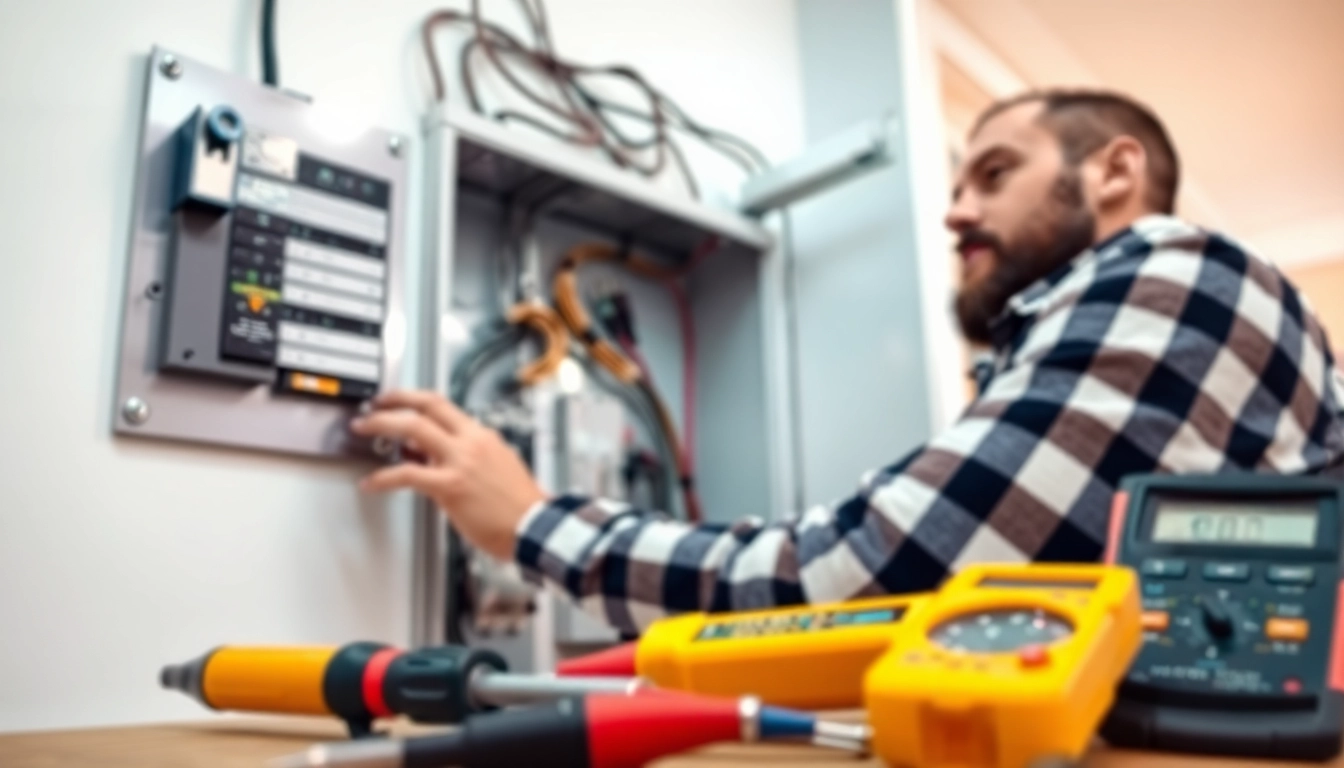Understanding Electrical Panel Upgrade Basics
Electrical panels act as the distribution center for electricity in your home, regulating how power is consumed by various devices and appliances. As our energy consumption habits evolve—thanks to new technologies, larger appliances, and electric vehicles—many homeowners find that their existing panels can no longer meet their needs. An Electrical Panel Upgrade is often necessary to accommodate these changes. In this guide, we will delve into the reasons for upgrades, signs that an upgrade is needed, and the numerous benefits that come with modernizing your electrical panel.
What is an Electrical Panel?
The electrical panel, often called a breaker box or service panel, is a crucial component of your home’s electrical system. It houses circuit breakers or fuses that protect your home’s wiring and appliances from damage caused by overloads and faults. Essentially, it serves as the point of entry for electricity from the utility company and distributes it to your home’s circuits. The typical capacities for electrical panels range from 60 to 200 amps, depending on the age of the home and its electrical needs.
Signs You Need an Electrical Panel Upgrade
Identifying the signs that indicate the need for an upgrade can help prevent dangerous situations and ensure your home is safe and efficient. Here are some key indicators:
- Frequent Circuit Breaker Tripping: If you notice that your breakers are tripping often, it may indicate that your panel is overloaded and cannot handle the power demands of your home.
- Flickering or Dimming Lights: This could suggest that your panel is struggling to supply power adequately, particularly when multiple appliances are in use.
- Old or Outdated Panel: Homes built before the 1980s often have outdated panels that may not meet modern electrical standards or capacity requirements.
- Increased Electrical Needs: If you’ve recently added major appliances, a home office, or electric vehicles, you may need more power than your current panel can provide.
- Burning Smells or Hot Breakers: Any signs of overheating or strange odors are serious issues and warrant immediate investigation, often indicating a need to upgrade the panel.
Benefits of Upgrading Your Electrical Panel
Upgrading your electrical panel not only addresses immediate issues but also offers several long-term advantages:
- Increased Electrical Capacity: An upgraded panel can significantly increase your home’s amperage capacity, accommodating more electronic devices and appliances.
- Improved Safety: New panels come with modern safety features and better circuit breakers, reducing the risk of electrical fires.
- Enhanced Home Value: Potential buyers appreciate updated electrical systems, which can make your home more attractive on the market.
- Convenience for Tech-Savvy Homes: With the rise of smart home devices, an upgraded panel can ensure that your home is future-proofed for new technologies.
- Lower Insurance Premiums: Some insurance companies offer discounts on premiums for homes with upgraded electrical systems, considering them less of a risk.
Planning for Your Electrical Panel Upgrade
Before proceeding with an upgrade, proper planning is essential. This will help maximize the benefits and ensure a smooth transition.
Assessing Your Electrical Needs
Begin by performing a thorough assessment of your electrical needs. Take into account activities within your home:
- List all high-wattage appliances (e.g., ovens, air conditioners, dryers).
- Note the distance from the main panel to the devices, as longer distances can affect amperage.
- Consider planned renovations or future purchases—if you plan to add an electric vehicle in the future, prepare for that higher demand now.
Choosing the Right Amperage for Your Home
Once you assess your needs, you can determine the appropriate amperage for your new panel. The following guidelines can help:
- 100 Amps: This is often sufficient for smaller homes or those with minimal appliances.
- 150 Amps: Suitable for average-sized homes with several major appliances.
- 200 Amps: Recommended for larger homes, homes with numerous electronic devices, or future upgrades (e.g., home theaters, electric vehicles).
Budgeting for Upgrades: Costs and Savings
The cost of an electrical panel upgrade can vary significantly based on several factors:
- Type of Panel: Standard panels will generally be less expensive than smart or advanced panels.
- Installation Costs: Labor costs depend on your location and the complexity of the installation, ranging from $1000 to $3000 for an average project.
- Add-on Expenses: Don’t forget to account for permits, additional wiring, or circuit replacements.
- Long-Term Savings: While the initial cost might be significant, significantly improved energy efficiency and reduced insurance costs can lead to savings over time.
Electrical Panel Upgrade Process Steps
The upgrade process should be carefully approached to ensure safety and compliance with regulations.
Hiring a Qualified Electrician
Upgrading an electrical panel is not a DIY project. It requires specialized knowledge and expertise:
- Check Credentials: Ensure the electrician is licensed, insured, and has experience with panel upgrades.
- Get Multiple Quotes: To ensure competitive pricing, obtain quotes from several electricians before making a decision.
- Review References: Ask for references or check online reviews to analyze past work and customer satisfaction.
Permits and Regulations You Should Know
Electrical work often requires permits to ensure compliance with local codes. Here’s what you need to know:
- Contact your local jurisdiction to understand specific requirements for your area.
- Permit costs can vary, typically ranging from $50 to several hundred dollars depending on the project.
- Make sure the electrician you hire is familiar with the necessary codes and permits to avoid delays.
Timeframe for Completing the Upgrade
The timeframe for an electrical panel upgrade can vary depending on several factors:
- Size of the Home: Larger homes may take longer to upgrade than smaller homes.
- Complexity of the Installation: If your home requires extensive rewiring or changes, expect the project to take longer.
Generally, a straightforward upgrade can be completed in a day, while more extensive projects might take several days.
Common Mistakes to Avoid During Electrical Panel Upgrade
Upgrading your electrical panel is a significant investment, and avoiding common pitfalls can help streamline the process.
Ignoring Local Codes and Standards
Each region has codes that dictate how electrical systems should be set up:
- Make sure your electrician adheres to these standards to avoid legal issues and ensure safety.
- Not following local codes could result in fines, render your insurance void in case of an incident, or even necessitate a redo of the work.
Overlooking Safety Procedures
Safety should always be your top priority:
- Ensure that power is turned off before any work begins.
- Use proper equipment and tools to avoid potential injury or damage.
Underestimating Project Costs
Accurate budgeting can help you avoid surprises:
- Account for all potential costs, including unforeseen issues that may arise during the upgrade.
- It’s wise to set aside a contingency fund (around 10-20% of the total estimated cost) for unexpected expenses.
Post-Upgrade Considerations and Maintenance
After the upgrade is complete, maintaining your electrical system is vital to ensure its longevity and performance.
Testing Your New Electrical Panel
Conducting tests post-installation can ensure that everything operates as it should:
- Have a qualified electrician perform tests to confirm that all circuit breakers are functioning correctly.
- Check for any unusual noises or smells emanating from the panel, as these could indicate issues.
Regular Maintenance Tips for Electrical Panels
Regular maintenance can enhance the safety and functionality of your electrical panel:
- Schedule periodic inspections by an electrician to spot any potential issues before they become serious.
- Keep the panel clean and free of obstructions, ensuring easy access in emergencies.
- Be attentive to any new signs of malfunctioning in your electrical system, and resolve them swiftly.
How Upgrades Affect Home Insurance and Value
One of the most important aspects of a home investment is its value:
- Upgrading your electrical panel could potentially increase your home’s market value.
- In many cases, insurers provide lower premiums for homes with upgraded systems, as new panels are associated with lower risks.
- Notify your insurance company about the upgrade to ensure your policy reflects the changes.
In conclusion, recognizing when and why to consider an Electrical Panel Upgrade can enhance the safety and efficiency of your home, meeting the demands of modern technology and increasing long-term property value. By carefully planning each stage of the upgrade process and avoiding common pitfalls, homeowners can enjoy the benefits that come with a well-functioning electrical system.


